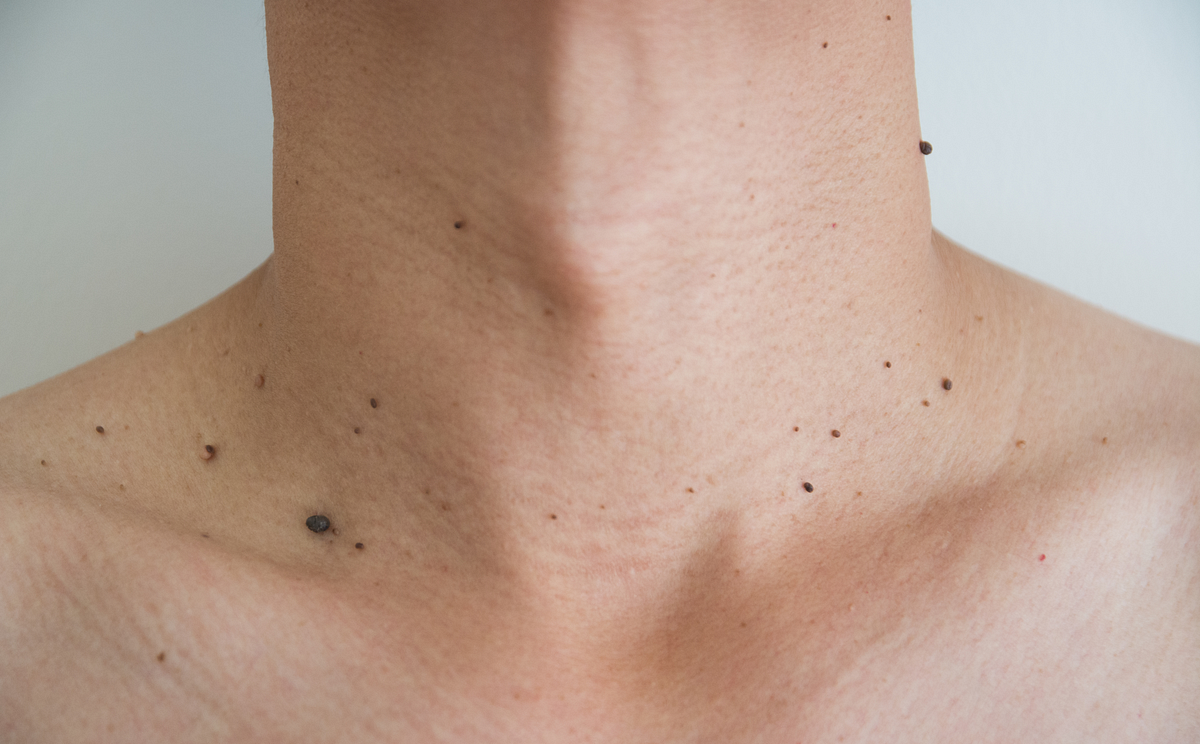Grunnleggende konsepter
Skin tags are common, benign growths that can occasionally signal underlying medical conditions if they multiply rapidly or grow excessively.
Sammendrag
The content discusses skin tags, which are small, fleshy growths that commonly appear on the skin. Key points include:
Skin tags are very common, affecting up to 46% of the US population. They are typically found in areas where skin rubs against skin or clothing, such as the neck, underarms, groin, and beneath the breasts.
Skin tags are almost always benign and harmless, but can be unsightly and may get snagged on clothing or jewelry, leading to irritation and inflammation.
In rare cases, a sudden increase in the number of skin tags or the development of excessively large skin tags can signal an underlying medical condition, such as polycystic ovary disease, diabetes, metabolic syndrome, or a hormonal disorder called acromegaly.
Skin tags are composed of blood vessels and collagen proteins wrapped in skin. They are connected to the skin's surface by a narrow stalk, which can sometimes twist and cut off the blood supply, causing the tag to turn black or purple and eventually fall off on its own.
The exact reason for skin tag growth is not fully understood, but factors like friction, obesity, and genetics may play a role.
Skin Tags are Yucky but Usually Harmless, Unless You…
Statistikk
Up to 46% of the US population has skin tags.
A 30 cm (nearly 1 foot) skin tag was documented on a 56-year-old female.
An 18 cm (7-inch) skin tag was found in a man's armpit.
Sitater
"Skin tags were a common reason for visits to my dermatology office. Besides the unwanted look, the nubs often get snagged on clothing and jewelry, which may lead to inflammation and irritation."
"Skin tags are almost always benign — more meddlesome than worrisome. But if your skin tags suddenly multiply, which is rare, it can signal an underlying medical condition like polycystic ovary disease, diabetes, metabolic syndrome, or acromegaly (a hormonal disorder caused by too much growth hormone)."
Viktige innsikter hentet fra
by Annie Foley klokken medium.com 04-15-2024
https://medium.com/aha-science/skin-tags-are-yucky-but-usually-harmless-unless-you-49b8cab2a942
Dypere Spørsmål
What are the potential treatment options for removing or managing skin tags?
Skin tags can be removed or managed through various methods. One common approach is to have them snipped off by a healthcare provider using scissors or a scalpel, a procedure known as excision. Another method is cauterization, where the skin tag is burned off using heat. Cryotherapy involves freezing the skin tag with liquid nitrogen. Additionally, some over-the-counter treatments like skin tag removal creams or solutions are available, although their effectiveness may vary. It's essential to consult a healthcare professional before attempting any removal method to ensure safety and proper care.
How can one distinguish between a harmless skin tag and a potentially concerning growth that may require medical attention?
Distinguishing between a harmless skin tag and a potentially concerning growth can be challenging, but there are some key factors to consider. Skin tags are usually small, soft, and flesh-colored growths that are connected to the skin by a stalk. They typically do not cause pain or discomfort unless irritated. On the other hand, concerning growths may exhibit rapid growth, unusual colors like black or purple, irregular borders, bleeding, or changes in shape or size. If a growth displays any of these characteristics, it is advisable to seek medical attention promptly to rule out any underlying medical conditions or potential risks.
What lifestyle or environmental factors might contribute to the development of skin tags, and are there any preventive measures individuals can take?
Several lifestyle and environmental factors may contribute to the development of skin tags. Friction from skin rubbing against skin or clothing in areas like the neck, underarms, or groin can increase the likelihood of skin tag formation. Hormonal changes, obesity, diabetes, and genetic predisposition are also believed to play a role. To help prevent skin tags, individuals can try to reduce friction in susceptible areas by wearing loose-fitting clothing, maintaining a healthy weight, and practicing good hygiene. Regularly moisturizing the skin and keeping it clean may also help minimize the risk of skin tag development. If skin tags are a recurring issue, consulting a healthcare provider for personalized advice and management strategies is recommended.
0
